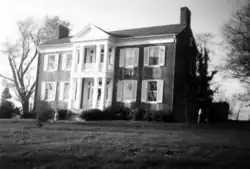Newell B. McClaskey House | |
 | |
| Coordinates | 37°55′24″N 85°16′16″W / 37.92333°N 85.27111°W |
|---|---|
| Built | 1835 |
| Architect | George Batcheldor |
| Architectural style | Greek Revival, Federal |
| NRHP reference No. | 00000269 |
| Added to NRHP | March 24, 2000[1] |
Newell Beauchamp McClaskey House is a historic site and building, a plantation house, and former plantation, located in Bloomfield, Kentucky which is part of the Bluegrass region.[2] At one time, this site was worked and maintained by enslaved African American people.[2]
It has been listed in the National Register of Historic Places since March 24, 2000, for its architectural significance.[3]
McClaskey family and history
The McClaskey family was descendant from Scottish immigrants, prior to the 1740s.[4] Newell Beauchamp McClaskey was an early settler of Nelson County.[2] By 1829, McClaskey had acquired over 700 acres of land.[2] The family cleared the land, built houses, farmed the land, and started a distillery.[2]
The house was built in 1835 for Newell Beauchamp McClaskey (1806–1865) and his wife, Nancy née Bodine (1807–1880).[2] After Nancy Bodine McClaskey's death in 1880, the site was left to their many children, and it stayed in the family heirs until 1938.[2]
The house was sold in 1944 to businessman and real estate developer James Graham Brown, former owner of the Brown Hotel in Louisville, Kentucky.[2] Other owners included Ralph and Margaret Burgin (from 1947 to 1990), Laurin Wathen (from 1990 to 1991), and Rondell and Joyce Jacobs (from 1991 to ?).[2]
Architecture
The plantation house was designed and built by architect George Batcheldor (c. 1810–1879), who had come to Kentucky in 1830s from Massachusetts.[2] Batcheldor's other notable buildings in Kentucky include the Walnut Grove House, Duncan Hall, the Micajah Glasscock House, and the Gray House.[2]
The Newell B. McClaskey House has a five bay facade, with transom windows and sidelights, and central passage.[2] It was designed as Federal architecture-style, with Greek Revival architectural influences.[2] The complex includes a brick smokehouse, brick slave quarters with a gabled tin roof, two 19th century barns, and two corn cribs.[2]
See also
References
- ↑ "National Register Information System". National Register of Historic Places. National Park Service. November 2, 2013.
- 1 2 3 4 5 6 7 8 9 10 11 12 13 14 "National Register of Historic Places Inventory/Nomination: Newell B. McClaskey House". Kentucky Heritage Council. National Park Service, U.S. Department of the Interior. March 24, 2000. Retrieved June 22, 2021.
{{cite web}}: CS1 maint: others (link) (with accompanying photos) - ↑ "McClaskey, Newell B., House". NPGallery Asset Detail, National Park Service, United States Department of the Interior. Retrieved 2021-06-22.
- ↑ Thompson, Stith (1996). A Folklorist's Progress: Reflections of a Scholar's Life. Indiana University Press. p. 10. ISBN 978-1-879407-09-1.